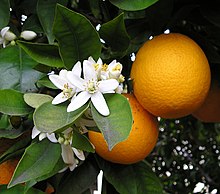Iorenji (isiqhamo)



Iorenji sisiqhamo seentlobo ezahlukeneyo ze-citrus kwintsapho yaseRutaceae (jonga uluhlu lwezityalo ezaziwa ngokuba ziorenji ); ibhekisa ikakhulu kwiCitrus × sinensis, [1] ekwabizwa ngokuba yiorenji eswiti, ukuyahlula kwiCitrus × aurantium ehambelana nayo, ekubhekiselwa kuyo njengeorenji ekrakra . I-orange emnandi ivelisa i-asexually ( i-apomixis ngokusebenzisa i-nucellar embryony ); Iindidi ze-orenji eziswiti zivela ngotshintsho. [2] [3]
Iorenji ngumxube phakathi kwepomelo ( Citrus maxima ) kunye nemandarin ( Citrus reticulata ). The chloroplast genome, and therefore the maternal line, is that of pomelo.[4] Iorenji eswiti inegenome yayo epheleleyo elandelelanayo . [5]
Iorenji yavela kummandla oquka i-Southern China, uMntla-mpuma we-Indiya, kunye neMyanmar, [6] [7] kwaye ukukhankanywa kwangaphambili kwe-orenji eswiti yayikuncwadi lwesiTshayina ngo-314 BC. [5] iThemplethi:As of, orange trees were found to be the most cultivated fruit tree in the world.[8] Imithi ye-orenji ikhuliswa kakhulu kwiindawo ezishushu kunye nemozulu eshushu ngenxa yeziqhamo zayo ezimnandi. Isiqhamo somthi we-orenji sinokutyiwa sisitsha, okanye silungiselwe incindi yaso okanye amaxolo anuka kamnandi. iThemplethi:As of, sweet oranges accounted for approximately 70% of citrus production.[9]
Ngo-2019, i-79 yezigidi zeetoni zeeorenji zakhuliswa kwihlabathi jikelele, kwaye iBrazil ivelisa i-22% yetotali, ilandelwa yi -China ne -Indiya . [10]
- ↑ "Citrus ×sinensis (L.) Osbeck (pro sp.) (maxima × reticulata) sweet orange" Plants.USDA.gov archived from the original on May 12, 2011 Unknown parameter
|url-status=ignored (help) - ↑ "Orange fruit nutrition facts and health benefits" retrieved 20 September 2018
- ↑ "Oranges: Health Benefits, Risks & Nutrition Facts" Live Science retrieved 20 September 2018
- ↑ Velasco, R; Licciardello, C (2014) "A genealogy of the citrus family" Nature Biotechnology 32 (7): 640–642 PMID 25004231 doi:10.1038/nbt.2954 Unknown parameter
|s2cid=ignored (help); Unknown parameter|doi-access=ignored (help) - ↑ 5.0 5.1 Xu, Q; Chen, LL; Ruan, X; Chen, D; Zhu, A; Chen, C; Bertrand, D; Jiao, WB; Hao, BH; Lyon, MP; Chen, J (Jan 2013) "The draft genome of sweet orange (Citrus sinensis)" Nature Genetics 45 (1): 59–66 PMID 23179022 doi:10.1038/ng.2472 Unknown parameter
|doi-access=ignored (help) Cite error: Invalid<ref>tag; name "fullgenome" defined multiple times with different content - ↑ Morton, Julia F. (1987) Fruits of Warm Climates pp. 134–142
- ↑ Talon, Manuel; Caruso, Marco; Gmitter, Fred G. Jr. (2020) The Genus Citrus Woodhead Publishing p. 17 ISBN 9780128122174
- ↑ Morton, J (1987) "Orange, Citrus sinensis. In: Fruits of Warm Climates" NewCROP, New Crop Resource Online Program, Center for New Crops & Plant Products, Purdue University pp. 134–142
- ↑ Organisms. Citrus Genome Database
- ↑ "Production of oranges in 2020, Crops/Regions/World list/Production Quantity (pick lists)" UN Food and Agriculture Organization, Corporate Statistical Database (FAOSTAT) 2020 retrieved 21 March 2021
